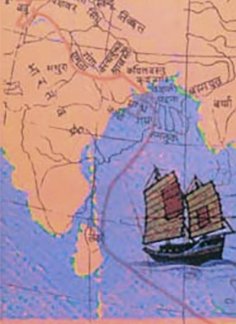Bai, Bāi: 6 definitions
Introduction:
#Bai means something in the history of ancient India, Marathi, Hindi, biology. If you want to know the exact meaning, history, etymology or English translation of this term then check out the descriptions on this page. Add your comment or reference to a book if you want to contribute to this summary article.
India history and geography
Source: Cologne Digital Sanskrit Dictionaries: Indian Epigraphical Glossary
Bāi or Bāī.—(EI 8), honorific epithet or name-ending of ladies in Western India; cf. Bāyi, Bā.º Note: bāi is defined in the “Indian epigraphical glossary” as it can be found on ancient inscriptions commonly written in Sanskrit, Prakrit or Dravidian languages.

The history of India traces the identification of countries, villages, towns and other regions of India, as well as mythology, zoology, royal dynasties, rulers, tribes, local festivities and traditions and regional languages. Ancient India enjoyed religious freedom and encourages the path of Dharma, a concept common to Buddhism, Hinduism, and Jainism.
Biology (plants and animals)
Source: Google Books: CRC World Dictionary (Regional names)
Bai in Philippines is the name of a plant defined with Maranta arundinacea in various botanical sources. This page contains potential references in Ayurveda, modern medicine, and other folk traditions or local practices It has the synonym Phrynium variegatum N.E. Brown (among others).
Example references for further research on medicinal uses or toxicity (see latin names for full list):
· Annales Botanici Fennici (2005)
· Species Plantarum. (1797)
· Manual de Plantas de Costa Rica
· Rapid Assessment Program Working Papers (1998)
· Biodiversidad del estado de Tabasco (2005)
· Abhandlungen der Königlichen Akademie der Wissenschaften in Berlin (1884)
If you are looking for specific details regarding Bai, for example extract dosage, health benefits, side effects, pregnancy safety, diet and recipes, chemical composition, have a look at these references.

This sections includes definitions from the five kingdoms of living things: Animals, Plants, Fungi, Protists and Monera. It will include both the official binomial nomenclature (scientific names usually in Latin) as well as regional spellings and variants.
Languages of India and abroad
Marathi-English dictionary
Source: DDSA: The Molesworth Marathi and English Dictionary
bāi (बाइ).—f A term of respectful compellation or mention for one’s mother or an elderly female. 2 It is an affix of respect to the names of females gen. Ex.ramābāī ālī āṇi ākābāī gēlī. 3 pl and sometimes n sometimes m for Lady, mistress &c. Ex. bāī kōṭhēṃ gēlīṃ na kaḷē. See mātōśrī. 4 C pl The small pox. v yē. bāyāṃ bāpaḍīcā Pertaining or relating to weak and helpless females.
Source: DDSA: The Aryabhusan school dictionary, Marathi-English
bāī (बाई).—f A term of respectful mention for one’s mother or an elderly female. Ex. ramābāī, ākābāī, &c. Lady, mistress &c. pl The small pox. bāyāṃ bāpaḍīcā Pertaining or relating to weak and helpless females.
Marathi is an Indo-European language having over 70 million native speakers people in (predominantly) Maharashtra India. Marathi, like many other Indo-Aryan languages, evolved from early forms of Prakrit, which itself is a subset of Sanskrit, one of the most ancient languages of the world.
Hindi dictionary
Source: DDSA: A practical Hindi-English dictionary
1) Bāī (बाई):—(nf) one of the three humours of the body (see [bāta]); gout, rheumatism; delirium; a lady; a prostitute; —[jī] a prostitute; a respectful form of address for a woman (esp. in Rajasthan); —[caḍhanā] to be in a state of delirium; —[pacanā] delirious disturbance in one’s system to subside.
2) Bai (बै):—(nf) sale (of a farm or plot of land, etc); ~[nāmā] the saledeed (of a plot of land, farm, etc.).
…
Kannada-English dictionary
Source: Alar: Kannada-English corpus
Bai (ಬೈ):—
1) [verb] to put in the ground and cover with earth or under the surface of water.
2) [verb] to install or establish firmly at.
3) [verb] to mingle; to become mixed with.
4) [verb] to keep a person or thing bound (restraining the movement).
— OR —
Bai (ಬೈ):—
1) [verb] to find fault with angrily; to chide, reprimand using harsh wors; to scold.
2) [verb] to affend by speaking contemptuously; to insult in a jeering manner.
— OR —
Bai (ಬೈ):—[noun] the last part of the day; the period around sunset; evening.
— OR —
Bai (ಬೈ):—[noun] hollow stalks or stems of paddy after threshing, used for fodder, for bedding, for making hats, etc.; straw.
Kannada is a Dravidian language (as opposed to the Indo-European language family) mainly spoken in the southwestern region of India.
See also (Relevant definitions)
Starts with (+391): Bai badang, Bai bai, Bai bao jin gu cao, Bai bao qin, Bai bao xing xing cao, Bai bei feng, Bai bian dou, Bai bu, Bai chang, Bai che zhou cao, Bai dou kou, Bai dou shan, Bai er cai, Bai fen teng, Bai gen miao, Bai gu cai, Bai gu ding, Bai guo, Bai guo bai zhu, Bai he qi.
Ends with (+104): Abai, Aibai, Ajabai, Ajibai, Akabai, An derabai, Aparubai, Asabai, Asle-labai, Assabai, Babai, Bai bai, Bei mei qiao bai, Bei mei xiang bai, Bhagubai, Bhukadabai, Blue rambai, Bobai, Bubai, Budabhabai.
Full-text (+205): Bais, Baisa, Bai guo bai zhu, Bai bai, Laghalamavashi -Bhavani -Bai, Manubai, Aparupai, Huang bai, Bai tan, Bai-kumbhi, Hai bai, Bai thong daeng, Seki pui bai, Bai gu cai, Bai shao yao, Bai yan shui, Bai ru, Da bai bu, Bai chang, Bai ma.
Relevant text
Search found 21 books and stories containing Bai, Bāi, Bāī; (plurals include: Bais, Bāis, Bāīs). You can also click to the full overview containing English textual excerpts. Below are direct links for the most relevant articles:
Chaitanya Bhagavata (by Bhumipati Dāsa)
Verse 2.8.239 < [Chapter 8 – The Manifestation of Opulences]
Verse 3.3.81 < [Chapter 3 – Mahāprabhu’s Deliverance of Sarvabhauma, Exhibition of His Six-armed Form, and Journey to Bengal]
Verse 2.1.263 < [Chapter 1 – The Beginning of the Lord’s Manifestation and His Instructions on Kṛṣṇa-saṅkīrtana]
South Indian Music – Srimati Saraswati Bai < [September-October, 1929]
Who’s Who Among our Contributors < [July – September, 1995]
Waterman Narappa < [July 1953]
Annadatri-carita (study) (by Sarannya V.)
4. Political Dimensions in Annadatri-carita < [Chapter 5 – Annadatri-carita—A Critical Study]
7. Divinity Applied on Travancore Royal Family < [Chapter 5 – Annadatri-carita—A Critical Study]
1. Social and Economical Aspects in Annadatri-carita < [Chapter 5 – Annadatri-carita—A Critical Study]
Buddha-nature (as Depicted in the Lankavatara-sutra) (by Nguyen Dac Sy)
1.1. Āryadeva and His Works < [Chapter 3 – The Laṅkāvatārasūtra and Hindu Philosophy]
3. The Buddha-nature Today: A New Approach < [Conclusion]
Blue Annals (deb-ther sngon-po) (by George N. Roerich)
Chapter 4 – Mind Class < [Book 3 – Early translations of Secret Mantra]
Chapter 1b – Detailed transmission history from dynastic period < [Book 3 – Early translations of Secret Mantra]
Chapter 1c – The Zur Geneology (xxi): Continuation of the zur lineage < [Book 3 – Early translations of Secret Mantra]
Bodhisattvacharyavatara (by Andreas Kretschmar)
Text Section 284 / Stanza 27 < [Khenpo Chöga’s Oral Explanations]
Text Section 151-153 < [Khenpo Chöga’s Oral Explanations]
Post view 603 times



Leave a Reply